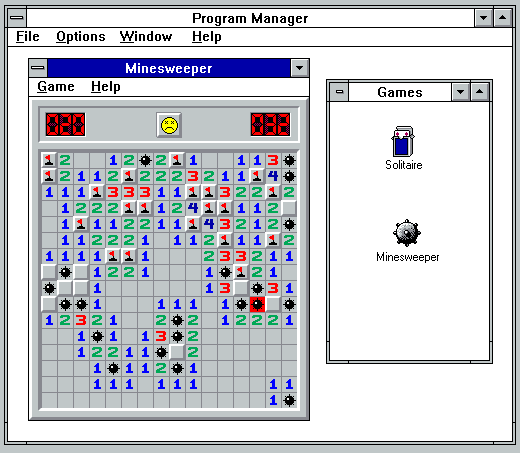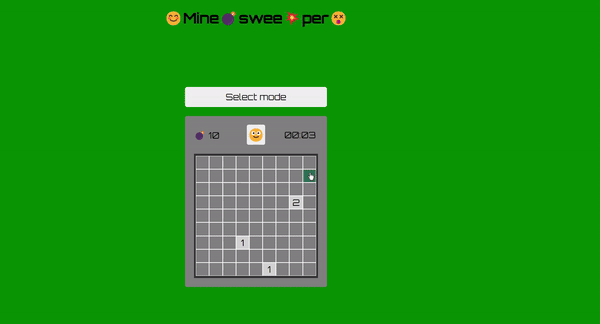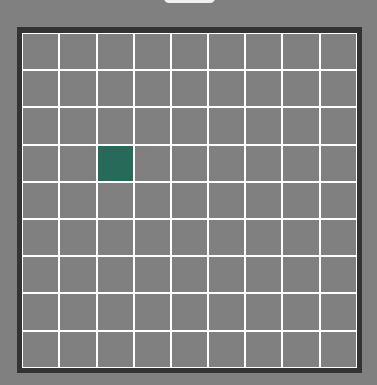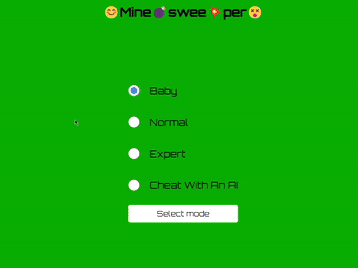Svelte 的掃雷
Background
I never understood as a kid how this game worked, I used to open this game up in Win95 IBM PC, and just click randomly around until I hit a mine. Now that I do, I decided to recreate the game with Svelte.
Lets break it down - How the game works ?
Minesweeper is a single player board game with a goal of clearing all tiles of the board. The player wins if he clicks all the tiles on the board without mines and loses if he clicks on a tile that holds a mine.

Game starts with all tiles concealing what is beneath it, so its a generally a lucky start to the game, you could click on either a empty tile or a mine. In case its not a empty tile or a mine, it could hold a count of mine that are present adjacent to the currently clicked tile.

As an example here 1 at the top left indicates there is 1 mine in of its adjacent cells. Now what do we mean by adjacent cells ? All cells that surround a cell become its adjacent cells. This allows players to strategize about clicking on which tile next. In case a user is not sure whether there is a mine or not underneath a tile, he can flag it by right clicking on the tile.

Thinking about the game logic
The game is pretty simple at first glance, just give a board of n x m rows and keep switching the cell state to display the content that each cell holds. But there is a case where if multiple empty cells are connected and you click on it, the game should keep opening adjacent cells if they are empty too, that gives its iconic ripple effect.

Gets quite tricky building all these conditions in, so lets break down into smaller tasks at hand.
- Create a board state - a n x m array (2d array)
- A cell inside a board could be / can hold: a mine, a count, or empty.
- A cell can be: clicked / not clicked.
- A cell can be: flagged / not flagged.
- Represent cell with these properties: row, col, text, type(mine, count, empty), clicked(clicked / not clicked), flagged (flagged / not flagged).
- Finally we could represent a game state like this: on, win, lose
- We also need to have a way to define bounds, while we create that ripple, we don't want the ripple to open up mines too! So we stop open tiles once we hit a boundary of mine!
- A game config: row, cols, mine count -> This could help us add difficulty levels to our game easily. Again this is optional step.
- This game is just calling a bunch of functions...on click event.
Creating board state
Creating a board is simple task of creating a 2d array given that we know the number of rows and columns. But along with that we also want to put mines at random spots in the board and annotate the board with the mine count in the adjacent cells of mine.
We create a list of unique random indices to put mines at, below function is used to do that,
function uniqueRandomIndices(
row_count: number,
col_count: number,
range: number,
) {
const upper_row = row_count - 1;
const upper_col = col_count - 1;
const idxMap = new Map();
while (idxMap.size !== range) {
const rowIdx = Math.floor(Math.random() * upper_row);
const colIdx = Math.floor(Math.random() * upper_col);
idxMap.set(`${rowIdx}_${colIdx}`, [rowIdx, colIdx]);
}
return [...idxMap.values()];
}
So here is function that we use to create board state
function createBoard(
rows: number,
cols: number,
minePositions: Array>,
) {
const minePositionsStrings = minePositions.map(([r, c]) => `${r}_${c}`);
let boardWithMines = Array.from({ length: rows }, (_, row_idx) =>
Array.from({ length: cols }, (_, col_idx) => {
let cell: Cell = {
text: "",
row: row_idx,
col: col_idx,
type: CellType.empty,
clicked: CellClickState.not_clicked,
flagged: FlagState.not_flagged,
};
if (minePositionsStrings.includes(`${row_idx}_${col_idx}`)) {
cell.type = CellType.mine;
cell.text = CellSymbols.mine;
}
return cell;
}),
);
return boardWithMines;
}
Once we do have a board with mines in random spots, we will end up with a 2d array. Now the important part that makes it possible to play at all, adding mine count to adjacent cells of a mine. For this we have couple of things to keep in mind before we proceed with it.
We have to work within the bounds for any given cell, what are these bounds ?
Bounds here simply means range of rows and cols through which we can iterate through to get all adjacent cells. We need to make sure these bounds never cross the board, else we will get an error or things might not work as expected.
So adjacent cells means each cell that touches current cell on sides or vertices. All the red cells are adjacent cells to the green cell in the middle as per the figure below.

const getMinIdx = (idx: number) => {
if (idx > 0) {
return idx - 1;
}
return 0;
};
const getMaxIdx = (idx: number, maxLen: number) => {
if (idx 1 > maxLen - 1) {
return maxLen - 1;
}
return idx 1;
};
const getBounds = (row_idx: number, col_idx: number) => {
return {
row_min: getMinIdx(row_idx),
col_min: getMinIdx(col_idx),
row_max: getMaxIdx(row_idx, rows),
col_max: getMaxIdx(col_idx, cols),
};
};
function annotateWithMines(
boardWithMines: Cell[][],
minePositions: number[][],
) {
for (let minePosition of minePositions) {
const [row, col] = minePosition;
const bounds = getBounds(row, col);
const { row_min, row_max, col_min, col_max } = bounds;
for (let row_idx = row_min; row_idx
We now have a board with mines and now we need to display this board with some html/ CSS,
{#each board as rows}
{#each rows as cell}
{/each}
{/each}
This renders a grid on page, and certain styles applied conditionally if a cell is clicked, flagged. You get a good old grid like in the screenshot below

Cell and the clicks...
Cell and its state is at the heart of the game. Let's see how to think in terms of various state a cell can have
A cell can have:
- Empty content
- Mine
- Count - adjacent to a mine
A cell can be:
- Open
- Close
A cell can be:
- Flagged
- Not Flagged
export enum CellType {
empty = 0,
mine = 1,
count = 2,
}
export enum CellClickState {
clicked = 0,
not_clicked = 1,
}
export enum CellSymbols {
mine = "?",
flag = "?",
empty = "",
explode = "?",
}
export enum FlagState {
flagged = 0,
not_flagged = 1,
}
export type Cell = {
text: string;
row: number;
col: number;
type: CellType;
clicked: CellClickState;
flagged: FlagState;
};
Rules for a cell:
- On left click, click a cell opens and on a right click cell is flagged.
- A flagged cell cannot be opened but only unflagged and then opened.
- A click on empty cell should open all its adjacent empty cells until it hits a boundary of mine cells.
- A click on cell with mine, should open all the mine with cell and that end the game
With this in mind, we can proceed with implementing a click handler for our cells
const handleCellClick = (event: MouseEvent) => {
switch (event.button) {
case ClickType.left:
handleLeftClick(event);
break;
case ClickType.right:
handleRightClickonCell(event);
break;
}
return;
};
Simple enough to understand above function calls respective function mapped to each kind of click , left / right click
const explodeAllMines = () => {
for (let [row, col] of minePositions) {
board[row][col] = {
...board[row][col],
text: CellSymbols.explode,
};
}
};
const setGameLose = () => {
game_state = GameState.lose;
};
const handleMineClick = () => {
for (let [row, col] of minePositions) {
board[row][col] = {
...board[row][col],
clicked: CellClickState.clicked,
};
}
setTimeout(() => {
explodeAllMines();
setGameLose();
}, 300);
};
const clickEmptyCell = (row_idx: number, col_idx: number) => {
// recursively click adjacent cells until:
// 1. hit a boundary of mine counts - is it same as 3 ?
// 2. cells are already clicked
// 3. cells have mines - same as 1 maybe
// 4. cells that are flagged - need to add a flag feature as well
if (board[row_idx][col_idx].type === CellType.count) {
return;
}
const { row_min, row_max, col_min, col_max } = getBounds(row_idx, col_idx);
// loop over bounds to click each cell within the bounds
for (let r_idx = row_min; r_idx {
if (event.target instanceof HTMLButtonElement) {
const row_idx = Number(event.target.dataset.row);
const col_idx = Number(event.target.dataset.col);
const cell = board[row_idx][col_idx];
if (
cell.clicked === CellClickState.not_clicked &&
cell.flagged === FlagState.not_flagged
) {
board[row_idx][col_idx] = {
...cell,
clicked: CellClickState.clicked,
};
switch (cell.type) {
case CellType.mine:
handleMineClick();
break;
case CellType.empty:
clickEmptyCell(row_idx, col_idx);
break;
case CellType.count:
break;
default:
break;
}
}
} else {
return;
}
};
Left click handler - handles most of the game logic, it subdivided into 3 sections based on kind of cell the player clicks on:
Mine cell is clicked on
If a mine cell is clicked we call handleMineClick() function, that will open up all the mine cells, and after certain timeout we display an explosion icon, we stop the clock and set the game state to lost.
Empty cell is clicked on
If a empty cell is clicked on we need to recursively click adjacent empty cells until we hit a boundary of first counts. As per the screenshot, you could see when I click on the bottom corner cell, it opens up all the empty cells until the first boundary of counts.
Count cell is clicked on
Handling count cell is simply revealing the cell content beneath it.

Game state - Final bits and pieces
Game Difficulty can be configured on the basis of ratio of empty cells to mines, if the mines occupy 30% of the board, the game is too difficult for anyone to play, so we set it up incrementally higher up to 25%, which is still pretty high
export const GameDifficulty: Record = {
baby: { rows: 5, cols: 5, mines: 2, cellSize: "40px" }, // 8% board covered with mines
normal: { rows: 9, cols: 9, mines: 10, cellSize: "30px" }, // 12% covered with mines
expert: { rows: 16, cols: 16, mines: 40, cellSize: "27px" }, // 15% covered with mines
"cheat with an AI": { rows: 16, cols: 46, mines: 180, cellSize: "25px" }, // 25% covered with mines - u need to be only lucky to beat this
};
Game state is divided into 3 states - win, lose and on
export enum GameState {
on = 0,
win = 1,
lose = 2,
}
export type GameConfig = {
rows: number;
cols: number;
mines: number;
cellSize: string;
};
We also add a timer for the game, that start as soon as the game starts, I have separated it in a timer.worker.js, but it might be an overkill for a small project like this. We also have a function to find the clicked cells count, to check if user has clicked all the cells without mines.
let { rows, cols, mines, cellSize } = GameDifficulty[difficulty];
let minePositions = uniqueRandomIndices(rows, cols, mines);
let game_state: GameState = GameState.on;
let board = annotateWithMines(
createBoard(rows, cols, minePositions),
minePositions,
);
let clickedCellsCount = 0;
let winClickCount = rows * cols - minePositions.length;
$: flaggedCellsCount = mines;
$: clickedCellsCount = calculateClickedCellsCount(board);
$: if (clickedCellsCount === winClickCount) {
game_state = GameState.win;
}
let timer = 0;
let intervalWorker: Worker;
let incrementTimer = () => {
timer = 1;
};
$: if (clickedCellsCount >= 1 && timer === 0) {
intervalWorker = new Worker("timer.worker.js");
intervalWorker.addEventListener("message", incrementTimer);
intervalWorker.postMessage({
type: "START_TIMER",
payload: { interval: 1000 },
});
}
$: timerDisplay = {
minute: Math.round(timer / 60),
seconds: Math.round(timer % 60),
};
$: if (game_state !== GameState.on) {
intervalWorker?.postMessage({ type: "STOP_TIMER" });
}
const calculateClickedCellsCount = (board: Array>) => {
return board.reduce((acc, arr) => {
acc = arr.reduce((count, cell) => {
count = cell.clicked === CellClickState.clicked ? 1 : 0;
return count;
}, 0);
return acc;
}, 0);
};
And we have got a great minesweeper game now !!!

This is a very basic implementation of Minesweeper, we could do more with it, for starters we could represent the board state with bitmaps, which makes it infinitely...Could be a great coding exercise. Color coding the mine count could be a good detail to have, there are so many things to do with it...this should be a good base to work with...
In case you want to look at the complete code base you could fork / clone the repo from here:
https://github.com/ChinmayMoghe/svelte-minesweeper
-
 如何從Python中的字符串中刪除表情符號:固定常見錯誤的初學者指南?從python import codecs import codecs import codecs 導入 text = codecs.decode('這狗\ u0001f602'.encode('utf-8'),'utf-8') 印刷(文字)#帶有...程式設計 發佈於2025-04-01
如何從Python中的字符串中刪除表情符號:固定常見錯誤的初學者指南?從python import codecs import codecs import codecs 導入 text = codecs.decode('這狗\ u0001f602'.encode('utf-8'),'utf-8') 印刷(文字)#帶有...程式設計 發佈於2025-04-01 -
 可以在純CS中將多個粘性元素彼此堆疊在一起嗎?[2这里: https://webthemez.com/demo/sticky-multi-header-scroll/index.html </main> <section> { display:grid; grid-template-...程式設計 發佈於2025-04-01
可以在純CS中將多個粘性元素彼此堆疊在一起嗎?[2这里: https://webthemez.com/demo/sticky-multi-header-scroll/index.html </main> <section> { display:grid; grid-template-...程式設計 發佈於2025-04-01 -
 如何配置Pytesseract以使用數字輸出的單位數字識別?Pytesseract OCR具有單位數字識別和僅數字約束 在pytesseract的上下文中,在配置tesseract以識別單位數字和限制單個數字和限制輸出對數字可能會提出質疑。 To address this issue, we delve into the specifics of Te...程式設計 發佈於2025-04-01
如何配置Pytesseract以使用數字輸出的單位數字識別?Pytesseract OCR具有單位數字識別和僅數字約束 在pytesseract的上下文中,在配置tesseract以識別單位數字和限制單個數字和限制輸出對數字可能會提出質疑。 To address this issue, we delve into the specifics of Te...程式設計 發佈於2025-04-01 -
 如何使用node-mysql在單個查詢中執行多個SQL語句?Multi-Statement Query Support in Node-MySQLIn Node.js, the question arises when executing multiple SQL statements in a single query using the node-mys...程式設計 發佈於2025-04-01
如何使用node-mysql在單個查詢中執行多個SQL語句?Multi-Statement Query Support in Node-MySQLIn Node.js, the question arises when executing multiple SQL statements in a single query using the node-mys...程式設計 發佈於2025-04-01 -
 如何簡化PHP中的JSON解析以獲取多維陣列?php 試圖在PHP中解析JSON數據的JSON可能具有挑戰性,尤其是在處理多維數組時。 To simplify the process, it's recommended to parse the JSON as an array rather than an object.To do...程式設計 發佈於2025-04-01
如何簡化PHP中的JSON解析以獲取多維陣列?php 試圖在PHP中解析JSON數據的JSON可能具有挑戰性,尤其是在處理多維數組時。 To simplify the process, it's recommended to parse the JSON as an array rather than an object.To do...程式設計 發佈於2025-04-01 -
 如何在JavaScript對像中動態設置鍵?在嘗試為JavaScript對象創建動態鍵時,如何使用此Syntax jsObj['key' i] = 'example' 1;不工作。正確的方法採用方括號: jsobj ['key''i] ='example'1; 在JavaScript中,數組是一...程式設計 發佈於2025-04-01
如何在JavaScript對像中動態設置鍵?在嘗試為JavaScript對象創建動態鍵時,如何使用此Syntax jsObj['key' i] = 'example' 1;不工作。正確的方法採用方括號: jsobj ['key''i] ='example'1; 在JavaScript中,數組是一...程式設計 發佈於2025-04-01 -
 為什麼使用Firefox後退按鈕時JavaScript執行停止?導航歷史記錄問題:JavaScript使用Firefox Back Back 此行為是由瀏覽器緩存JavaScript資源引起的。要解決此問題並確保在後續頁面訪問中執行腳本,Firefox用戶應設置一個空功能。 警報'); }; alert('inline Alert')...程式設計 發佈於2025-04-01
為什麼使用Firefox後退按鈕時JavaScript執行停止?導航歷史記錄問題:JavaScript使用Firefox Back Back 此行為是由瀏覽器緩存JavaScript資源引起的。要解決此問題並確保在後續頁面訪問中執行腳本,Firefox用戶應設置一個空功能。 警報'); }; alert('inline Alert')...程式設計 發佈於2025-04-01 -
 如何使用組在MySQL中旋轉數據?在關係數據庫中使用mySQL組使用mySQL組進行查詢結果,在關係數據庫中使用MySQL組,轉移數據的數據是指重新排列的行和列的重排以增強數據可視化。在這裡,我們面對一個共同的挑戰:使用組的組將數據從基於行的基於列的轉換為基於列。 Let's consider the following ...程式設計 發佈於2025-04-01
如何使用組在MySQL中旋轉數據?在關係數據庫中使用mySQL組使用mySQL組進行查詢結果,在關係數據庫中使用MySQL組,轉移數據的數據是指重新排列的行和列的重排以增強數據可視化。在這裡,我們面對一個共同的挑戰:使用組的組將數據從基於行的基於列的轉換為基於列。 Let's consider the following ...程式設計 發佈於2025-04-01 -
 Python讀取CSV文件UnicodeDecodeError終極解決方法在試圖使用已內置的CSV模塊讀取Python中時,CSV文件中的Unicode Decode Decode Decode Decode decode Error讀取,您可能會遇到錯誤的錯誤:無法解碼字節 在位置2-3中:截斷\ uxxxxxxxx逃脫當CSV文件包含特殊字符或Unicode的路徑逃...程式設計 發佈於2025-04-01
Python讀取CSV文件UnicodeDecodeError終極解決方法在試圖使用已內置的CSV模塊讀取Python中時,CSV文件中的Unicode Decode Decode Decode Decode decode Error讀取,您可能會遇到錯誤的錯誤:無法解碼字節 在位置2-3中:截斷\ uxxxxxxxx逃脫當CSV文件包含特殊字符或Unicode的路徑逃...程式設計 發佈於2025-04-01 -
 哪種方法更有效地用於點 - 填點檢測:射線跟踪或matplotlib \的路徑contains_points?在Python Matplotlib's path.contains_points FunctionMatplotlib's path.contains_points function employs a path object to represent the polygon.它...程式設計 發佈於2025-04-01
哪種方法更有效地用於點 - 填點檢測:射線跟踪或matplotlib \的路徑contains_points?在Python Matplotlib's path.contains_points FunctionMatplotlib's path.contains_points function employs a path object to represent the polygon.它...程式設計 發佈於2025-04-01 -
 Java是否允許多種返回類型:仔細研究通用方法?在Java中的多個返回類型:一種誤解類型:在Java編程中揭示,在Java編程中,Peculiar方法簽名可能會出現,可能會出現,使開發人員陷入困境,使開發人員陷入困境。 getResult(string s); ,其中foo是自定義類。該方法聲明似乎擁有兩種返回類型:列表和E。但這確實是如此嗎...程式設計 發佈於2025-04-01
Java是否允許多種返回類型:仔細研究通用方法?在Java中的多個返回類型:一種誤解類型:在Java編程中揭示,在Java編程中,Peculiar方法簽名可能會出現,可能會出現,使開發人員陷入困境,使開發人員陷入困境。 getResult(string s); ,其中foo是自定義類。該方法聲明似乎擁有兩種返回類型:列表和E。但這確實是如此嗎...程式設計 發佈於2025-04-01 -
 如何使用Java.net.urlConnection和Multipart/form-data編碼使用其他參數上傳文件?使用http request 上傳文件上傳到http server,同時也提交其他參數,java.net.net.urlconnection and Multipart/form-data Encoding是普遍的。 Here's a breakdown of the process:Mu...程式設計 發佈於2025-04-01
如何使用Java.net.urlConnection和Multipart/form-data編碼使用其他參數上傳文件?使用http request 上傳文件上傳到http server,同時也提交其他參數,java.net.net.urlconnection and Multipart/form-data Encoding是普遍的。 Here's a breakdown of the process:Mu...程式設計 發佈於2025-04-01 -
 為什麼我的CSS背景圖像出現?故障排除:CSS背景圖像未出現 ,您的背景圖像儘管遵循教程說明,但您的背景圖像仍未加載。圖像和样式表位於相同的目錄中,但背景仍然是空白的白色帆布。 而不是不棄用的,您已經使用了CSS樣式: bockent {背景:封閉圖像文件名:背景圖:url(nickcage.jpg); 如果您的html,cs...程式設計 發佈於2025-04-01
為什麼我的CSS背景圖像出現?故障排除:CSS背景圖像未出現 ,您的背景圖像儘管遵循教程說明,但您的背景圖像仍未加載。圖像和样式表位於相同的目錄中,但背景仍然是空白的白色帆布。 而不是不棄用的,您已經使用了CSS樣式: bockent {背景:封閉圖像文件名:背景圖:url(nickcage.jpg); 如果您的html,cs...程式設計 發佈於2025-04-01 -
 在Java中使用for-to-loop和迭代器進行收集遍歷之間是否存在性能差異?For Each Loop vs. Iterator: Efficiency in Collection TraversalIntroductionWhen traversing a collection in Java, the choice arises between using a for-...程式設計 發佈於2025-04-01
在Java中使用for-to-loop和迭代器進行收集遍歷之間是否存在性能差異?For Each Loop vs. Iterator: Efficiency in Collection TraversalIntroductionWhen traversing a collection in Java, the choice arises between using a for-...程式設計 發佈於2025-04-01 -
 如何使用Python的請求和假用戶代理繞過網站塊?如何使用Python的請求模擬瀏覽器行為,以及偽造的用戶代理提供了一個用戶 - 代理標頭一個有效方法是提供有效的用戶式header,以提供有效的用戶 - 設置,該標題可以通過browser和Acterner Systems the equestersystermery和操作系統。通過模仿像Chro...程式設計 發佈於2025-04-01
如何使用Python的請求和假用戶代理繞過網站塊?如何使用Python的請求模擬瀏覽器行為,以及偽造的用戶代理提供了一個用戶 - 代理標頭一個有效方法是提供有效的用戶式header,以提供有效的用戶 - 設置,該標題可以通過browser和Acterner Systems the equestersystermery和操作系統。通過模仿像Chro...程式設計 發佈於2025-04-01
學習中文
- 1 走路用中文怎麼說? 走路中文發音,走路中文學習
- 2 坐飛機用中文怎麼說? 坐飞机中文發音,坐飞机中文學習
- 3 坐火車用中文怎麼說? 坐火车中文發音,坐火车中文學習
- 4 坐車用中文怎麼說? 坐车中文發音,坐车中文學習
- 5 開車用中文怎麼說? 开车中文發音,开车中文學習
- 6 游泳用中文怎麼說? 游泳中文發音,游泳中文學習
- 7 騎自行車用中文怎麼說? 骑自行车中文發音,骑自行车中文學習
- 8 你好用中文怎麼說? 你好中文發音,你好中文學習
- 9 謝謝用中文怎麼說? 谢谢中文發音,谢谢中文學習
- 10 How to say goodbye in Chinese? 再见Chinese pronunciation, 再见Chinese learning

























